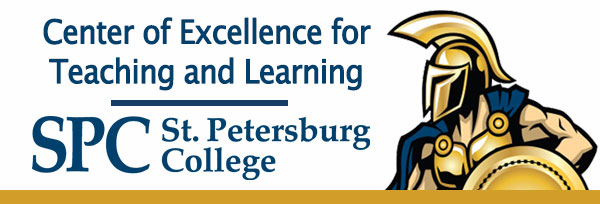Build:
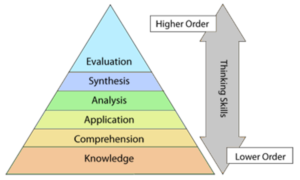 Designing Courses: Start Designing
Designing Courses: Start Designing
Developing foundational Course Design skills will benefit you as a faculty member. Whether you are teaching from a master course, designing your course content from scratch, or re-designing an existing course, the resources on this page can help you get started.
Basic Course Design
Most course design begins with identifying the Major Learning Outcomes (MLOs) we anticipate our students will achieve in their time in our class. There has been extensive research into the development of MLOs but if you are here on this website, you were likely given the MLOs for the course you are to design.
For now, a basic understanding of how learning objectives are constructed should assist you in your course design process. Learning objectives enable teachers and students alike to understand the purpose of their interaction and enable you to plan for and create meaningful learning opportunities for your students. Review below to learn the basics of how learning objectives are built.
Bloom’s Taxonomy
Bloom’s Taxonomy originated in 1956 in a 6-part framework as illustrated below:
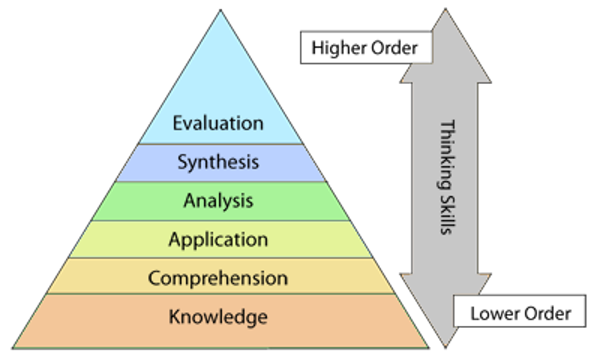
Alt Text: Bloom’s Taxonomy of Learning
Pyramid structure showing the 6-part framework. Beginning at the bottom in the widest segment is knowledge and moving up the parts are comprehension, application, analysis, synthesis, and evaluation. The higher up on the pyramid, the higher order the thinking skills required.
As illustrated by the graphic, students’ thinking skills should progress from knowledge through the other nouns in the pyramid. In 2001 a group of cognitive psychologists, curriculum theorists and instructional researchers, and testing and assessment specialists published a revision of Bloom’s Taxonomy (LINK). This revised taxonomy adds verbs and gerunds and emphasizes the dynamic nature of learning and classification of learning. The revision also includes a set of “action verbs” that “describe the cognitive process by which thinkers encounter and work with knowledge.”
The 2022 Revised Taxonomy is illustrated below:
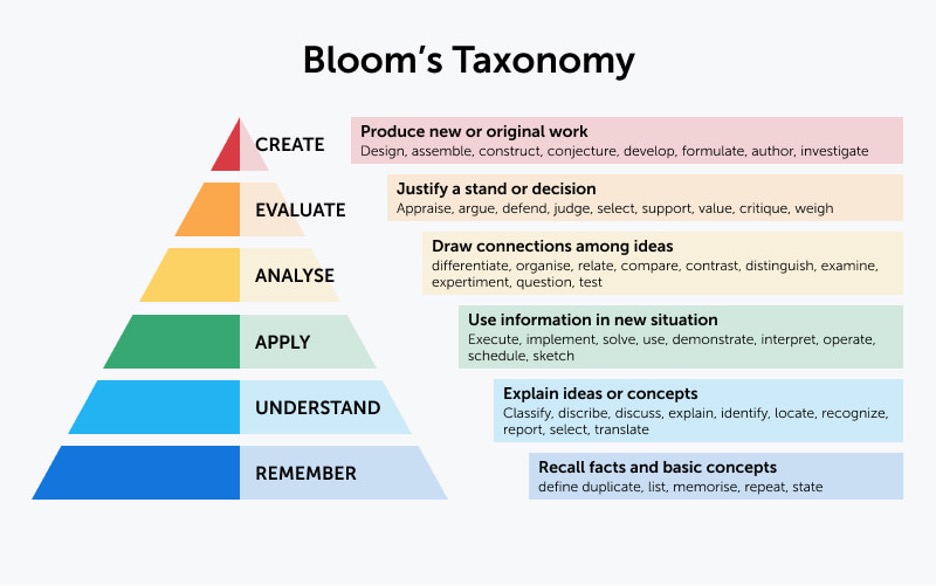
| Bloom’s Level | Key Verbs (keywords) | Example Learning Objective |
|---|---|---|
| Create | design, formulate, build, invent, create, compose, generate, derive, modify, develop. | By the end of this lesson, the student will be able to design an original homework problem dealing with the principle of conservation of energy. |
| Evaluate | choose, support, relate, determine, defend, judge, grade, compare, contrast, argue, justify, support, convince, select, evaluate. | By the end of this lesson, the student will be able to determine whether using conservation of energy or conservation of momentum would be more appropriate for solving a dynamics problem. |
| Analyze | classify, break down, categorize, analyze, diagram, illustrate, criticize, simplify, associate. | By the end of this lesson, the student will be able to differentiate between potential and kinetic energy. |
| Apply | calculate, predict, apply, solve, illustrate, use, demonstrate, determine, model, perform, present. | By the end of this lesson, the student will be able to calculate the kinetic energy of a projectile. |
| Understand | describe, explain, paraphrase, restate, give original examples of, summarize, contrast, interpret, discuss. | By the end of this lesson, the student will be able to describe Newton’s three laws of motion to in her/his own words |
| Remember | list, recite, outline, define, name, match, quote, recall, identify, label, recognize. | By the end of this lesson, the student will be able to recite Newton’s three laws of motion. |
Using Learning Objectives to Design Your Course
You can access SPC’s MLOs by:
- Requesting them from your Dean, Program Director, or Department Chair OR
- Accessing the Curricunet site: https://www.curricunet.com/stpetersburg/search/course/
- You do not have to sign in! Click on Search and then choose Course
- Choose the 3-letter CoursePrefix from the pull down menu or type it in
- Enter the 4-digit course number, omitting any course type designations of C, L, H, etc. and click the Search button to see all variations of course outlines
- Find the most recent Active outline, and click the W (Microsoft Word) icon to the left of the listing to see course description, credits and contact hours, requisites and learning objectives.
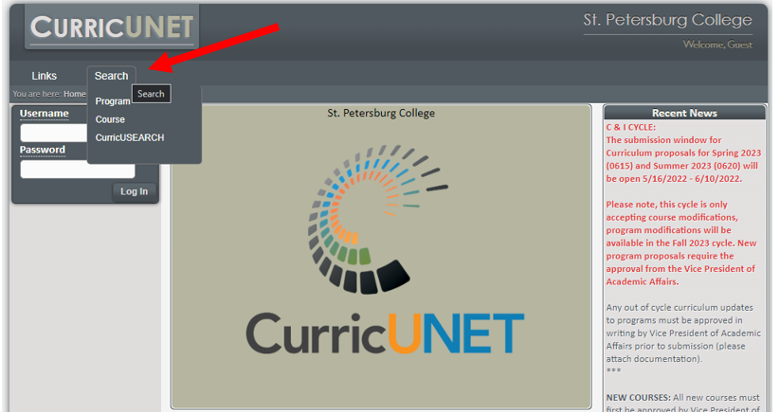

Once you have reviewed the learning objectives you should consider how the course content, assignments, assessments, and activities align with the course learning objectives. Many faculty rely on a module-based approach which is demonstrated in the chart below. The general idea is that you start with the MLO, consider what activities students will engage in, what you will do to provide instruction and support, and determine what type of assessment and feedback will appropriately determine students’ acquisition of knowledge.
You can seek additional support in this process by reaching out to either the IDEAS or CETL teams: ideas@spcollege.edu or cetl@spcollege.edu.
Example of Planning a Module Based on MLOs
|
Module (Sample) Learning Objectives What will students be able to do by the end of this module? |
Assessment & Feedback Strategy | Instructional Materials & Course Technology What materials and resources will you use to help the student achieve the module objective? |
Activities What learning activities will you provide to help the student achieve the module objective? Indicate interaction type in parentheses: Learner-to-Learner (L-L), Learner-to-Instructor (L-I), Learner-to-Content (L-C) |
|
1a. Identify types of business structures suited to typical new small businesses.
|
Quiz: Types of Business, self-check quiz after reading with automatic feedback. |
Textbook, Business Law, Ch 2 Video, YouTube, interview with alumna Mod 1 discussion questions Checklist |
Reading, Business Law, Ch 2, checklist (L-C) Discussion: Module 1 questions, muddiest point (L-L, L-I) Softchalk interactive (L-C) |
Preparing an Effective Syllabus
Your Syllabus is your “contract” for the course with your students. You can use this Syllabus Template created by the IDEAS Team to create your own for each class. All SPC Faculty are expected to provide a course syllabus to their students. This Syllabus should be posted in Canvas by the Thursday before the term starts so that students are able to access it when courses open for viewing.
A syllabus lets students know what the course is about, why the course is taught, where it is going, and what will be required for them to be successful in the course. Clear communication of expectations can help you in avoiding many misunderstandings and student challenges. Lastly, remember that your Syllabus will likely be your students’ first look at your course and you as the faculty member.
The syllabus as a contract
A syllabus should make the rules for the course clear. It should set forth what is expected to happen during the semester, delineate the responsibilities of students and of the instructor, and describe appropriate procedures and course policies. To do this, a syllabus should include the following:
- Topics and readings to be covered in sequence with dates
- Important dates (e.g., assignment due dates, exam dates, and holidays)
- Description of how the final grade will be computed with a breakdown of the ranges for each letter grade
- Policy on late assignments, incomplete assignments, and revisions
- Academic integrity policy
- Attendance policy
- Accommodation policy for students with special needs
- Expectations for class interaction
- Live Online webcam policy verbiage
The syllabus as a permanent record
A syllabus should serve accountability and documentation functions. It should document what was covered in a course, at what level, and for what kind of credit. Such a syllabus contains information useful for the evaluation of instructors, courses, and programs, and can thus be useful in course equivalency transfer situations, accreditation procedures, and articulation. To do this, a syllabus should include the following:
- Basic course information (course by number, section, title, semester, meeting times, days, place, format)
- Instructor information (name, title, office location, office phone number, e-mail)
- Description of the course content
- Course goals and objectives
- Required purchases for the course. You may also want to note where else texts will be available (e.g., the library, online, electronic reserves)
- Pre- and co-requisites for the course (not just courses; what skills are expected also)
The syllabus as a learning tool
A syllabus should help students become more effective learners in the course. While many of these items are not required for syllabi at SPC, adding them can greatly improve students’ ability to learn the material. To do this, a syllabus should include the following:
- A conceptual structure used to organize the course, why it is organized the way it is
- Instructor’s philosophy about the course content, teaching, and learning
- Relevance and importance of the course to students (e.g., how the course fits into the college or department curriculum, why the students would want to learn the material)
- Campus resources available to help students’ learning (tutoring, writing, counseling, etc.)
- Estimate of student workload
- Hints for how to study, take notes, etc.
Additional Resources:
Armstrong, P. (2010). Bloom’s Taxonomy. Vanderbilt University Center for Teaching. Retrieved [6-30-2022] from https://cft.vanderbilt.edu/guides-sub-pages/blooms-taxonomy/
Chandio, Muhammad Tufail, Saima Murtaza Pandhiani, and Saima Iqbal. “Bloom’s Taxonomy: Improving Assessment and Teaching-Learning Process.” Journal of education and educational development 3.2 (2016): 203–221. Web. Retrieved [6-30-2022] https://spc-flvc.primo.exlibrisgroup.com/permalink/01FALSC_SPC/1veuhe4/cdi_doaj_primary_oai_doaj_org_article_51360c26fe6540eaa6d9e8e652135f5d
- For assistance with Canvas, our online learning management system contact the ATST TEAM: atst@spcollege.edu; Call 727.341.3500; (Monday – Friday 8:30 am – 4:30 pm EST)
- Canvas Tutorials: https://myresources.spcollege.edu/
Technology & Designing Courses
To find tutorials on Canvas and other technology challenges, visit: https://myresources.spcollege.edu/
Use the search to find answers to common questions including how-tos for:
- Opening a course for a student with an incomplete
- Copying content into your course shell
- Providing extra time on quizzes
- Getting the most out of faculty tools
- Overviews of Zoom and Honorlock
Level Up Your Design Game
The Promising Syllabus
Ken Bain is the author of “What the Best College Teachers Do” among other publications. In this book, he interviewed and observed hundreds of professors and endeavored to identify what pedagogical practices those who were most successful engaged in. You can read about his finding on the impact of the Syllabus here: [The Promising Syllabus]
- For more ways to Level Up Your Design Game, see our Professional Development opportunities

ATST Support Team
ATST@spcollege.edu
Call 727.341.3500
Mon.- Fri. 8:30am - 4:30pm EST (excluding college holidays).
IDEAS Support Team
Instructional Design, Education and Support.
Email: IDEAS@spcollege.edu
CETL Support Team
Email: CETL@spcollege.edu
Call: 727.791.2750
Hours: 9:00 am - 4:30 pm M-F
Upcoming Events
| Date/Time | Event |
|---|---|
|
01/01/26 All Day |
Faculty180 Annual Contract Forms Due |
|
01/10/26 All Day |
Adjunct Training Day Spring 2026 |
|
02/01/26 All Day |
Adjunct Evaluation Forms Due |
|
02/27/26 All Day |
2026 Teaching & Learning Conference |
|
04/24/26 12:00 am |
Faculty Recognition Breakfast |
